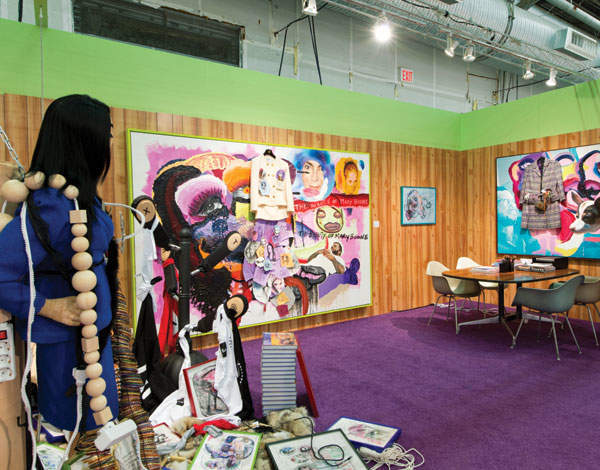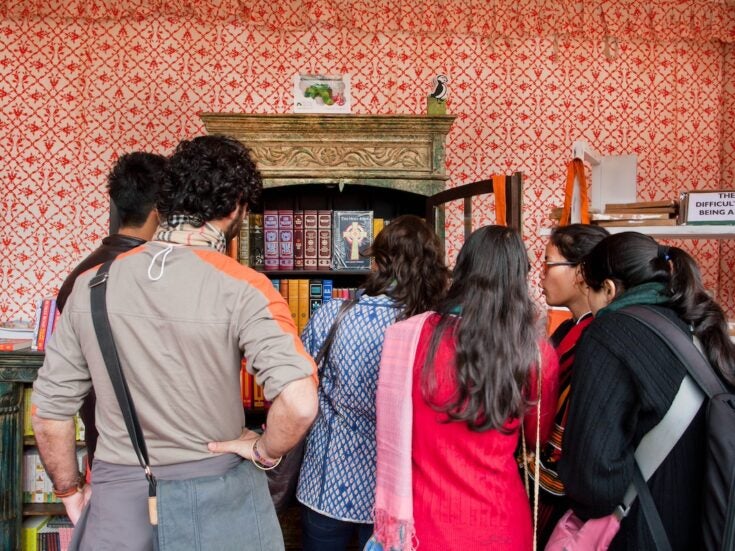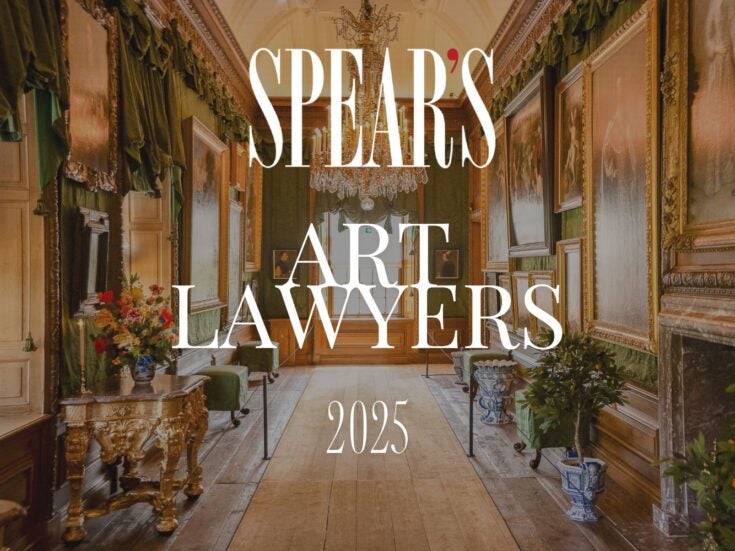

American artists have always tended to be skittish on the subject of humour. Saul Steinberg, for instance, was a great New Yorker cartoonist. But apparently you wouldn’t want to be the one to tell him that.
‘He saw himself in terms of Picabia or Klee,’ says Arne Glimcher of Pace, long-time dealer for Steinberg’s work. ‘Early Picabia. He always rejected the idea that he was a cartoonist.’ Inge Morath, the photographer wife of Arthur Miller, published a book called Masquerade, which consisted entirely of photographs of people wearing paper bags on their heads upon which Steinberg had drawn faces. But a cartoonist? Heavens, no!
Some years ago I was interviewing Claes Oldenburg and his wife Coosje van Bruggen. We were talking about Donald Judd, who had greatly admired Oldenburg’s work. I remarked that one difference between the two had been the total absence of humour in Judd.
‘Yeah! That’s the difference,’ Coosje agreed.
‘My viewpoint is that I seldom find anything humorous in my own work,’ the maker of the Soft Sculptures, oversized hamburgers and such, said solemnly. His wife and I looked at each other. We both laughed. ‘All right,’ he said, allowing himself a chuckle. ‘But I’m thinking about it as form.’ (Artists are frequently the least reliable people to talk about the springs of their own work. But you knew that already, right?)
I actually laughed in front of a Neil Jenney canvas at Gagosian a while back. A real laugh, not a knowing kind of giggle to show one has got the point, like those annoying folk who laugh at 400-year-old vernacular witticisms in Shakespeare’s comedies. I mentioned this to Jenney. He looked wary. ‘The humour was unnecessary baggage,’ he said.
The late and much missed Dennis Oppenheim was a past master at creating devices which use humour as part of a complicated arsenal. In Theme for a Major Hit, fifteen miniature bronze figures representing Oppenheim himself, dangling on strings, cavorted to music. Snowman Factory was just that, mixing comedy with a smidgen of dread, as in a children’s fable. But when I mentioned the humour element to Dennis, he too reacted like somebody being asked to swallow hot tar.
‘I let in the humour very carefully,’ he told me. ‘I use it when I’m dealing with very serious or tragic material. I don’t like to be overly funny.’
Upper Cut, a late series of Oppenheims, features gaping jaws with books instead of teeth. Their titles are broad jokes about his fellow artists, like Ed Ruscha’s New Peanut Butter Paintings. Yes, the intent here was to be overly funny, which is exactly why he did not consider Upper Cut as any more than secondary work.
Weeks ago I broached the subject with John Lurie. Lurie was the lead of the jazz-inflected Lounge Lizards, major figures in New York punk. But after Lyme disease, caught early and diagnosed late, put paid to his performing career, he refocused on a second passion, painting, becoming one of the rare rockers to make a convincing segue. His early work was cartoony and there were a few such in his recent New York show, like one with a thick forest, a deer and a traffic light. But only a few.
‘That’s the oldest one in the show,’ Lurie said when I drew attention to Deer and Stoplight. ‘When the paintings became not these kind of funny little cartoon things, some people became less interested in them. I know the paintings are funny but they are really abstract paintings, with a little something that sort of turns it into a story or into a fairytale for adults.
But they mostly start out as abstract paintings.’ There’s nothing abstract about his wordplay though. One canvas is called This Is Not the Pig’s Head You’re Thinking Of. That Is the Other Pig’s Head. Another, not in this show, has the title I Need To Know if There’s Life after Death and I Need to Know Kind of Soon. Darkly funny stuff.
All the above begs a question. Humour is not a no-no in Book World, where Mark Twain sits at the same table as Herman Melville, Evelyn Waugh with Graham Greene. But do Americans specifically distrust humour at the upper end of the visual arts? A nuanced answer is required, I think. It seems to be OK for an artist to make a funny piece from time to time — like John Baldessari’s I Will Not Make Any More Boring Art — especially if it’s a joke about Conceptual art. And it’s OK if it’s a Conceptual joke about humour, as with Richard Prince’s Joke Paintings, which recycle gags he retrieves from the internet. But is it OK if humour is an artist’s modus operandi, his or her working mindset, 24/7?
Yes, there have been such artists in the US. The astonishing work of New York’s Ray Johnson crackles with humour, and Red Grooms, Peter Saul and Jim Nutt spring to mind. All are well regarded but, as an auctioneer might put it, they are for the day sales, not the nocturnal extravaganzas. And, as the glum wisdom recommends, follow the money.
But Europe? Another story. And Willem de Kooning, an exception to the humourlessness of Abstract Expressionism, was a European, as Jackson Pollock would frequently remind him. In Europe, humour has always been considered a legitimate tool. Indeed, with Dada and Duchamp, it’s been an offensive weapon. Duchamp observed in a 1960 interview: ‘Humour was a sort of saviour so to speak because, before, art was such a serious thing, so pontifical that I was very happy when I discovered I could introduce humour into it. And that was truly a period of discovery.’
Duchamp also plugged his fellow Europeans for their humour quotient. ‘The important element introduced by Arp was “humour” in its subtlest form, the kind of whimsical conceptions that gave to the Dada movement an exuberant liveliness as opposed to the purely intellectual tendencies of Cubism and Expressionism,’ he wrote. ‘Arp showed the importance of a smile to combat the sophistic theories of the moment.’
European artists tend to be well aware of the humour gap with the US. I was talking with Francesco Vezzoli a few years ago — his Trailer for a Remake of Gore Vidal’s Caligula, a wondrously subversive short movie starring Courtney Love, Helen Mirren, Benicio del Toro and Vidal himself, had been a hit at the Venice Biennale in 2005. I mentioned the humour issue. Bingo!
He had been invited to take Caligula to the Whitney Biennial six months later. ‘I remember that whereas most of the people in the room in Venice were laughing their head off, which for me was such a fantastic sight, in the room at the Whitney Museum most of the American audience stood silent,’ he said. ‘I am not saying they did not like what I did. But for me it was painful to see that nobody was laughing. And that’s when I realised that when an American audience goes to a museum they do not expect to laugh. They think that that is a wrong reaction to have in a cultural realm.’
It is right here in New York, though, that I have been feeling the earth move. A couple of years back I was wandering the Armory art fair and encountered the elvish dealer Mary Boone. We chatted and moved on. Shortly after which I encountered the Mary Boone Installation…
The Mary Boone Installation (pictured) was at an Oslo gallery, Rod Bianco. It was the work of two Norwegian artists, Bjarne Melgaard and Sverre Bjertnes. Melgaard is terrific; as an expressive draughtsman he’s up there with Oldenburg. The Boone installation was described as a ‘homage’. Well, yes. In a way. One painting was lettered ‘MARY BOONE CRYING AFTER JULIAN SCHNABEL LEFT HER GALLERY’. Another reads: ‘MARY BOONE AS A CRACK ADDICT IN A CHANEL SUIT IN EIGHTIES’. Homage, you might say — or taking the mickey.
I asked Melgaard if he had spoken with Boone. ‘Of course,’ he said tranquilly. ‘I know her.’
OK, they are Scandinavians, as was the gallery, but the effect on the Armory struck me as galvanic. And now I see humour breaking out all over. Not, of course, among the derivative formalists who have been dominating the marketplace for way too long, that is — but maybe that’s why it’s so very welcome.
Anthony Haden-Guest is Arts Editor of Spear’s







